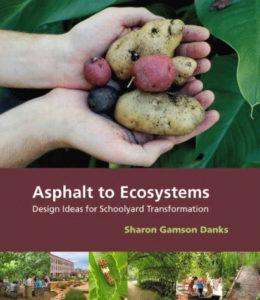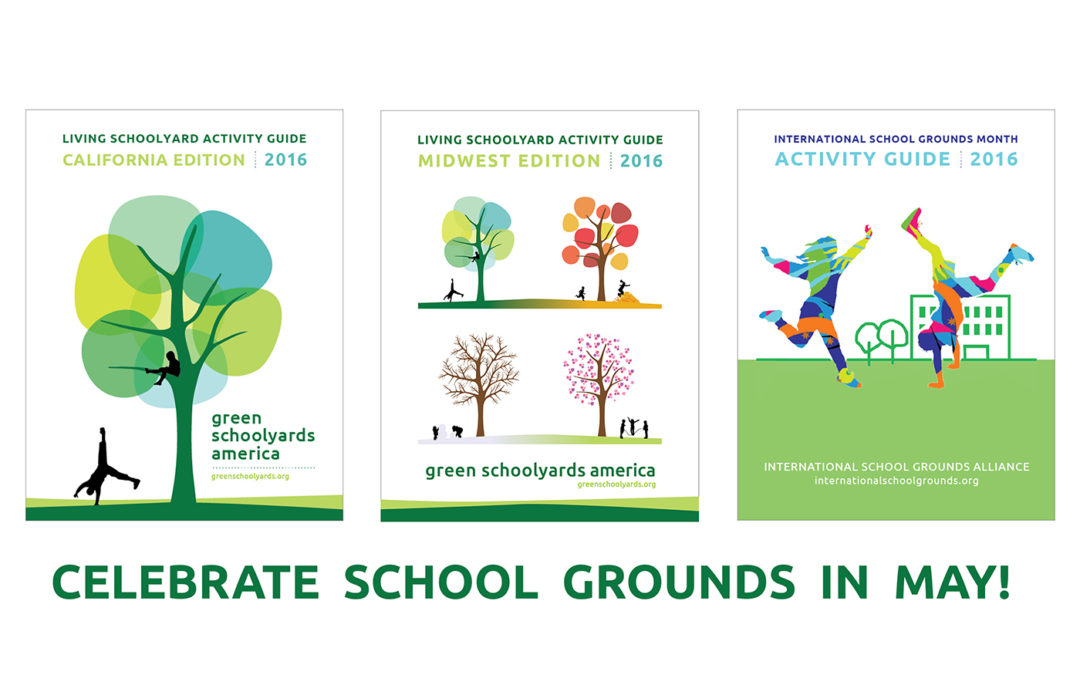By. Sharon Gamson Danks, CEO of Green Schoolyards America and co-founder of the International School Grounds Alliance
**This article was originally published as a blog post for the Children & Nature Network in May 2014 and has been updated for the May 2016 edition of GreenNotes.**
A seven-year-old girl stands in a courtyard garden with a paper cup in hand. The tall walls of the surrounding classrooms block noise from nearby urban streets and make the courtyard a quiet space for the goats, chickens, and children within. The little girl reaches up into the lush row of fava beans in front of her and carefully removes plump snails, placing them into her collecting cup. When she has gathered several snails, she runs to find one of the chickens contentedly roaming through the straw covered soil. A little boy scoops up a chicken and pets it while the girl feeds the snails she has just captured to the happy bird.
After observing this scene in the spring of 1998 at LeConte Elementary in Berkeley, California, I asked the children about their activities. The girl explained simply and clearly that the snails were harming their fava beans, so they had to be removed. The chickens loved eating the snails so they were given to the chickens. She added that her school composted chicken droppings to feed the soil and help the fava beans grow…and she loved fava beans so this type of garden work was important. From her explanation, it was obvious the young girl, growing up in an urban area, clearly understood the complex ecological cycles connecting their tasty crop to the snails, chickens, and soil. This simple but excellent elementary school garden had succeeded in teaching complex, integrated ecological concepts in a memorable way that young students understood.
This first exposure to a green schoolyard during graduate school resonated with me on a personal level and sparked an ongoing professional interest that I have been exploring ever since. One question I have asked myself over the years is, “How can we engage more children in the natural world every day, and weave it into the spaces and places they already visit in their neighborhoods?” School grounds are a big part of the answer in my mind, since they are the places that many children visit at least five days a week for twenty of the most formative years of their lives, as they move from preschool through high school, developing their view of the world and their place within it.
How can we make school grounds into rich, outdoor environments for all children? Large scale changes are needed to improve our school ground infrastructure, programming, and stewardship—but there are also many things we can do right now, on any school ground, to improve and enrich children’s experiences.
Richard Louv, co-founder of the Children & Nature Network, speaks of the idea of a “Homegrown Worldwide Park” created by all of us together, through our collective actions within the fabric of our own neighborhoods as we nurture our public and private outdoor spaces. The Homegrown Worldwide Park includes everyone’s front and backyards, where children play and neighbors gather, as well as city parks and other publicly-owned spaces such as school grounds. Taken together, these places can form the backbone of our urban, natural infrastructure and place nature within everyone’s reach in a meaningful way.
It is important to seek large scale, infrastructure changes to support nature and nature access in our cities—but we also have the power to start that transformation on our own patches of ground at home and at school, with our fellow community members. This transformation is both physical—bringing nature back to our cities—and mental—changing the way we use the spaces we create and the ones we already have.
During the month of May, the International School Grounds Alliance (ISGA) celebrates a “block party” of sorts within the school ground spaces of this Homegrown Worldwide Park, for Pre-K – 12 students and their communities. We call our annual May event International School Grounds Month. The state of California has also stepped up to the plate and adopted a resolution that not only encourages school districts to design and construct schoolyard green spaces for outdoor learning, but establishes May as Living Schoolyard Month, a time to celebrate school grounds state-wide.
Participate in Living Schoolyard Month and International School Grounds Month
You can participate in Living Schoolyard Month and International School Grounds Month by bringing children outside on your local school grounds during the month of May to connect with nature, or to simply enjoy the fresh air while doing any type of activity that sparks your imagination and is a good fit for your school community. The ideas below will help you get started. For more ideas and instructions for implementing them, download our 2016 Living Schoolyard Activity Guides:
- International School Grounds Month Activity Guide 2016. This activity guide includes 50 ideas from 37 organizations in 17 countries across the globe.
- Living Schoolyard Activity Guide – California Edition. This activity guide includes 59 ideas from 55 organizations across California.
- Living Schoolyard Activity Guide – Midwest Edition. This activity guide includes 38 ideas from 33 organizations working in the central United States.
The 2016 Living Schoolyard Activity Guides for California and the Midwest were developed by Green Schoolyards America in collaboration with our colleagues from more than 85 organizations across the United States, including schools and districts, local and state government agencies, non-profits, museums, universities, and businesses. The International School Grounds Month Activity Guide, edited and designed by Green Schoolyards America, was published by the ISGA and includes written contributions from 37 organizations in 17 countries. All of the organizations contributed a wide range of ideas to help schools bring students outside and use their order ambien cod school grounds to their fullest. Together, the three guides include 147 hands-on activities for Pre-K – 12 grade students that cover a range of topics including: Art, Recreation, Health, Wildlife Habitat, Watershed Stewardship, Schoolyard Agriculture, Energy and Climate, Thoughtful Use of Materials, and Place-Based Understanding.
Share Your Work and Learn from Others
We hope your schools and districts participate in Living Schoolyard Month and International School Grounds Month this May! After your celebration, please submit a brief summary of your activities so that we can share them on the ISGA or Green Schoolyards America blog in the months following the event. Please click here for directions on registering and sharing your school’s activities with the ISGA, and click here to do the same for Green Schoolyards America. Sharing your work will help us paint a global picture of the school ground portion of the Homegrown Worldwide Park, and will illustrate the variety of ways in which schools are getting their students outside this spring.
We know your work will inspire the children and adults in your school communities. We wish you well on your May celebrations of Living Schoolyard Month and International School Grounds Month, and hope to hear from you soon!
Ideas for Celebrating Living Schoolyard Month and International School Grounds Month
Looking for some quick ideas to celebrate your school grounds this May? Consider the following activities:
ENRICH ACADEMIC LESSONS
- Connect a lesson from your school’s curriculum to hands-on, schoolyard field work.
- Study the geology of rocks on your playground.
- Look for evidence of wildlife amid the asphalt or grass.
- Sit under a tree to read a story with a class of students.
- Examine the parts of a plant in the school garden and draw pictures to illustrate it.
- Track the movement of shadows across the pavement over the course of the day.
FOSTER CREATIVE PLAY
- Bring natural, loose materials such as pinecones, acorns, small rocks, sticks, and bark to the schoolyard and encourage students to make “fairy houses” or other imaginative, temporary sculptures.
- Give children larger natural materials to construct temporary forts or plant bean teepees using bamboo poles and scarlet runner beans to create playhouses with “living walls”.
EXPLORE THE ARTS
- Create chalk murals at recess to enliven the pavement and encourage creativity.
- Build large outdoor looms and teach children to create weavings with natural materials from the school garden.
- Grind small amounts of leaves, flowers, and soil to create natural pigments for painting.
- Create watercolor paintings or pencil drawings of the school garden, trees, or other plantings.
STUDY LOCAL ECOLOGY
- Measure the rainfall on the schoolyard during one day in May.
- Track the path of the rain as it travels from the roof of the school building across the pavement to the closest water body in the neighborhood.
- Explore the idea of microclimates by measuring and recording schoolyard temperatures at the hottest time of day on the asphalt, lawn, play structure, and under the shade of a tree.
- Hold a school wide competition between classrooms to count and record the number and type of wildlife species observed onsite over the course of the month.
PROMOTE LIFELONG HEALTH
- Harvest a salad or other items from the school garden and share with students.
- Teach children to bake bread using a schoolyard oven or make other campfire favorites with a Scandinavian-style schoolyard fire pit or a handmade, “pizza box” solar cooker.
- Hold a run-a-thon to raise money for the school and encourage fitness.
- Install a “nature play” zone that promotes unstructured, active play and physical activity.
- Teach children skills that are important for lifelong health including activities that promote balance, agility, and competent tool use.
ENGAGE THE COMMUNITY
- Install “social benches” in the schoolyard to encourage small groups of children and adults to gather for conversation. Consider using picnic tables, clusters of boulders, and other options.
- Hold a school-wide carnival to enjoy the spring weather!
*******
Green Schoolyards America is a national organization that expands and strengthens the green schoolyard movement and empowers Americans to become stewards of their school and neighborhood environments. Our mission is to inspire and enable communities across the United States to enrich their school grounds and use them to improve children’s wellbeing, learning, and play while promoting community engagement and contributing to the ecological health and resilience of cities. We believe that school grounds are uniquely positioned to enrich the daily lives of children and their communities, occupying both the geographic and social heart of almost every city across the USA and around the world. For more information, please visit our website at: http://www.greenschoolyards.org/
The International School Grounds Alliance (ISGA) is a global network of organizations and professionals that are working to enrich children’s learning and play by improving the way school grounds are designed and used. The well-being of children and the ecological diversity of their learning landscapes are intrinsically linked. The ISGA aims to support all schools in making the most of the opportunities excellent school grounds afford. For more information, please visit our website at: http://www.internationalschoolgrounds.org/
*******

About the Author
Environmental planner, Sharon Danks (MLA-MCP) is CEO of Green Schoolyards America, based in Berkeley, CA, and a Co-Founder of the International School Grounds Alliance. She is also the author of the book Asphalt to Ecosystems: Design Ideas for Schoolyard Transformation. Over the last eighteen years, her professional work and passion have focused on transforming school grounds into vibrant public spaces that reflect and enhance local ecology, engage the community, and nurture children as they learn and play. Her current work focuses on scaling up the green schoolyard movement and integrating design for children’s spaces with green urban infrastructure planning.
[1] Sharon Gamson Danks, Asphalt to Ecosystems:Design Ideas for Schoolyard Transformation, New Village Press, November 2010, p. ix. Modified text excerpt, used with permission.

